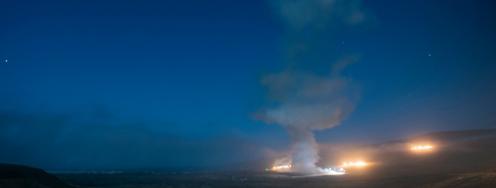Missile Defenses Complicating Strategic Stability in East Asia
On the radar: China, North Korea, and missile defense; Reading the N. Korean missile threat; Sec. Kerry on the crisis; Air Force seeks new nuclear capability; a Nonfunctioning, expensive solution; N. Korean missile part recovered; and Life in the Atomic City.
On the radar: China, North Korea, and missile defense; Reading the N. Korean missile threat; Sec. Kerry on the crisis; Air Force seeks new nuclear capability; a Nonfunctioning, expensive solution; N. Korean missile part recovered; and Life in the Atomic City.
April 15, 2013 | Edited by Benjamin Loehrke and Alyssa Demus
Balance and dialogue - The U.S. is adding to its missile defense presence in East Asia in response to the threat from North Korea. It’s unclear how this might be affecting the North, but the deployments could upset the strategic balance between the U.S. and China. Experts worry that Beijing might respond to U.S. missile defense plans by upgrading China’s nuclear arsenal - a problem exacerbated by the lack of regular U.S.-China nuclear dialogue.
--"The current development, especially the deployment of missile-defense systems in East Asia would be, in Chinese eyes, would be a very, very disturbing factor having implications for the calculation of China's nuclear and strategic arsenal," said Maj. Gen. Yao Yunzhu, a senior researcher at China's Academy of Military Science. Full article from Jeremy Page at The Wall Street Journal. http://on.wsj.com/1174Xoe
Intel in perspective - The barrage of North Korean missile threats and intelligence reports last week made it harder to sort reality from the rhetoric. Former intelligence professional Greg Thielmann suggests that those following the situation should start with what is known: “What is clear is that North Korea is not likely to have nuclear-tipped missile capable of threatening the U.S. mainland for quite some time. However, North Korea can launch on short notice a devastating artillery attack on the ten million inhabitants of Seoul, the capital of South Korea.” Full analysis here. http://bit.ly/17ButrP
Quote - ”The situation is that there is so little direct evidence that I don’t think it’s possible to come to a firm conclusion on whether or not [the North Koreans] currently have a nuclear warhead that can be delivered by missile, or how far away they are from getting there,” said former Obama WMD czar, Gary Samore. Full story from David Sanger and Eric Schmitt in The New York Times. http://owl.li/k4LG6
Kerry on Korea - “What we really ought to be talking about is the possibility of peace...And I think there are those possibilities...But fundamentally the concept is they’re going to have to show some kind of good faith here so that we are not going around and around. They have to indicate that seriousness of purpose to go toward the denuclearization,” Secretary Kerry said Sunday in Japan.
--The U.S. is willing to engage North Korea if Pyongyang makes “the first move to abandon [its] nuclear weapons,” said Kerry. Though the Secretary did not specify what a “move” entailed, it could include “a public commitment to denuclearization and such measures as halting the production of nuclear material, refraining from testing missiles and ceasing threats to attack its neighbors,” reports Michael Gordon of The New York Times. Full story here. http://owl.li/k4IVq
Welcome to Early Warning - Subscribe to our morning email or follow us on twitter.
--Have a tip or feedback for the editor? Email earlywarning@ploughshares.org earlywarning@ploughshares.org. Want to support this work? Click here.
B61 tailkit - “The Air Force plans to spend more than $1 billion to develop a tailkit to increase the accuracy of the B61 nuclear bomb,” writes Hans Kristensen at the Strategic Security Blog. The expensive, guided tailkit on the B61-12 would make the bomb more accurate and give it new capability to hold targets at risk, thereby increasing the capability of the U.S. nonstrategic nuclear weapons in Europe. Budget data and capability assessment here. http://bit.ly/135AUUj
Expensive and nonfunctional - The Obama administration’s budget request trimmed $500 million from the missile defense budget. “A deeper slice into the $10 billion the Pentagon spends each year on such programs wouldn’t make the U.S. one iota less safe, and would help with the $500 billion or so the Pentagon is likely to have to cut over a decade in any deficit-reduction deal,” writes Bloomberg in an editorial.
--The paper - a supporter of missile defense - reminds that “since the U.S. program’s inception, its governing philosophy has been to rush through research, ignore repeated testing failures and jump full force into production and deployment. The result: We have a nonfunctioning solution to a less-than-immediate problem.” Full article here. http://bloom.bg/XMZTdh
Missile recovery - The U.S. Navy recovered part of the first stage of the rocket North Korea tested last December, including part that “gave tangible proof that North Korea was building the missile’s cone at dimensions for a nuclear warhead.” Eli Lake at The Daily Beast has the story. http://thebea.st/ZVYyek
Tweet - @NuclearPolicy: Obama administration officials make the case for reevaluating and slowing down MoX program http://t.co/4RnsfdhAqU
Budgets and the ICBM leg - The coming defense budget reductions have sparked a debate from top military commanders and leading defense thinkers about if the U.S. still needs all three of its ICBM wings - each with 150 missiles. Experts suggest that, with the Cold War over, the U.S. could save money and provide for its deterrent needs with fewer ICBMs and/or fewer missile wings. Other analysts and former missile commanders argue for keeping the ICBM status quo.
--Full article “F.E. Warren’s Nuclear Future Could be in Jeopardy” by Trevor Brown in the Wyoming Tribune Eagle. http://bit.ly/17ByXyU
Tweet - @ForeignPolicy: Luttwak: The only way to stop North Korea's cycle of brinkmanship is to address the real problem -- South Korea atfp.co/Yw2hED
Events:
-- “Iran’s Nuclear Program: Assessing the Current State and Debating the Future.” Matthew Kroenig, Colin Kahl and Michael Eisenstadt. April 15, 6:30-8:00 pm at Georgetown. Details here. http://owl.li/k4Cvw
--"Are North Korea's Threats of War Real?” Joseph DeTrani, Bonnie Glaser and David Maxwell. April 16, 6:30-8:00 p.m. @ University of California Washington Center. Details here. http://owl.li/k4D2f
-- Senate Armed Services Committee, hearing on the Defense Department budget, with Defense Secretary Chuck Hagel and Joint Chiefs of Staff Chairman Gen. Martin Dempsey. April 17, 9:30 a.m. @ 216 Hart Senate Office Building. Webcast here. http://owl.li/k4Hao
--"Avoiding Armageddon: America, India, Pakistan, to the Brink and Back." Husain Haqqani and Bruce Riedel. April 17, 12:00-2:00 p.m. @ Hudson Institute. Details here. http://owl.li/k4Wro
--Senate Appropriations Subcommittee on Energy and Water, hearing on the National Nuclear Security Administration (NNSA) budget, with Neile Miller, Acting Administrator, NNSA. April 17, 2:30 p.m. @ 192 Dirksen Senate Office Building. Webcast here. http://owl.li/k4EOP
--Senate Armed Services Subcommittee on Strategic Forces, hearing on nuclear forces and policies, with Madelyn Creedon, Assistant Secretary of Defense for Global Strategic Affairs; Andrew Weber, Assistant Secretary of Defense for Nuclear, Chemical and Biological Defense Programs; and six military officials. April 17, 2:30 p.m. @ 222 Russell Senate Office Building. Webcast here. http://owl.li/k4FDt
--”Strategic Options for Iran: Balancing Pressure With Diplomacy.” Amb. William Luers, Amb. James Dobbins, Amb. Thomas Pickering, James Walsh and Carla Hills. April 17 12:15-2:00 p.m. @ Wilson Center. Details here. http://owl.li/k4GDo
--House Appropriations Subcommittee on Defense, hearing on the Defense Department budget, with Defense Secretary Chuck Hagel, Joint Chiefs of Staff Chairman Gen. Martin Dempsey and Defense Undersecretary Robert Hale. April 16 10:00 a.m. @ 2359 Rayburn House Office Building. Webcast here. http://owl.li/k4IEb
Dessert:
Tweet - @BBCNews: "Welcome to the real North Korea" - secret film by @BBCPanorama to be broadcast later. http://bbc.in/15ar0Ro
History lesson - In 1942, the U.S. government “bought up about 68,000 acres of land, and about 1,000 Tennessee families were given two weeks or less to vacate.” As part of the Manhattan Project, the government built a Top Secret Town, where the Little Boy bomb, dropped on Hiroshima, was built. Previously shrouded in secrecy, photos posted at Love These Pics depict life in “The Atomic City.” Pics here. http://owl.li/k4UjO



